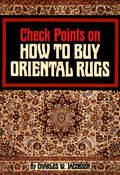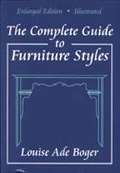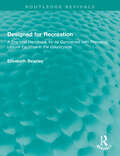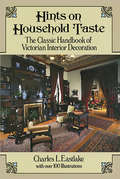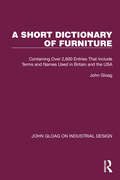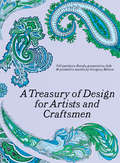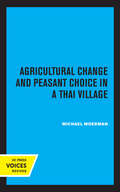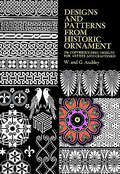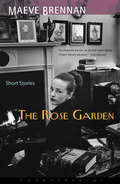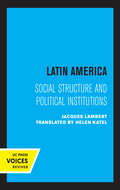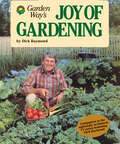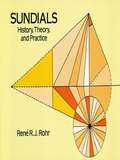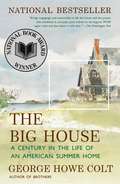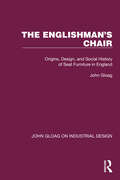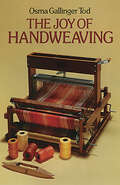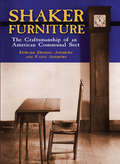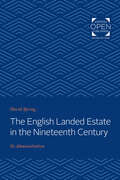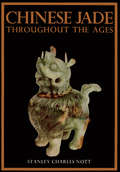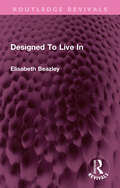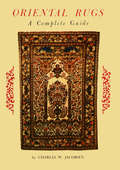- Table View
- List View
Check Points on How to Buy Oriental Rugs
by Charles W. JacobsenThe check points represent the essence of his five decades of experience in buying and selling new and antique Oriental rugs. Experienced dealers and first-time buyers alike will benefit from the expert information and advice Mr. Jacobsen offers.
Check Points on How to Buy Oriental Rugs
by Charles W. JacobsenThe check points represent the essence of his five decades of experience in buying and selling new and antique Oriental rugs. Experienced dealers and first-time buyers alike will benefit from the expert information and advice Mr. Jacobsen offers.
The Complete Guide To Furniture Styles
by Louise A. BogerInstilling a cultivated taste for all authentically creative furniture! From ancient Greece and Rome, through medieval times, and up to the present day, domestic furniture has been an integral part of civilization, and its study reveals much about our history and culture. This classic guide to furniture styles discusses the development of domestic furniture in Europe, America, and China, detailing the great periods of French and English furniture from the Renaissance through the Empire and Regency periods. Furniture from every age is represented in over 600 photographs of pieces from major collections throughout the world. The book's highly readable style and extensive coverage make it a valuable resource for interior designers.
Designed for Recreation: A Practical Handbook for All Concerned with Providing Leisure Facilities in the Countryside (Routledge Revivals)
by Elisabeth BeazleyOriginally published in 1969, at a time when there was an ever-increasing number of people going to the coast and countryside at weekends and on holiday, this book filled a gap by providing detail on the physical results of all that needed to be done for the leisure-seeking public. It discusses juggling the needs of the public whilst maintaining the quality of the natural environment – a balancing act which remains as relevant in the 21st Century as when the book was first published. The book is intended for all those making provision for public recreation and countryside protection. The passing of the Countryside Act in 1968 in the UK necessitated detailed work for local authorities: the design and siting of car parks; public lavatories; litter bins, camp and picnic sites; swimming pools and information centres to name but a few. Elisabeth Beazley discusses the principles involved and illustrates successful and cautionary examples from both sides of the Atlantic as well as Continental Europe
Hints on Household Taste: The Classic Handbook of Victorian Interior Decoration
by Charles L. EastlakePrimary authority on what was proper, beautiful, efficient in all aspects of mid-19th-century interior design. Originally published in 1868. Over 100 illustrations.
A Short Dictionary of Furniture: Containing Over 2,600 Entries That Include Terms and Names Used in Britain and the USA
by John GloagOriginally published in 1952 but enlarged and revised in 1969, this dictionary became a standard authoritative work of reference. It contains 2,612 entries and over 1,000 illustrations, reproduced from contemporary sources and from drawings by Ronald Escott, Marcelle Barton and Maureen Stafford. The work is divided into 6 sections: the first and second concern the description and design of furniture, the third contains the entries, the fourth gives a list of furniture makers in Britain and North America, section five records books and periodicals on furniture and design and the concluding section sets out in tabular form the periods with the materials used, and types of craftsmen employed from 1100 to 1950.
A Treasury of Design for Artists and Craftsmen (Dover Pictorial Archive)
by Gregory MirowIf you are an artist or designer, craftworker or art student, the price of this volume may be the best investment you've ever made. It contains an incredibly rich collection of bright, modern design material that is immediately usable — all selected especially for this volume from historical periods that are popular today, and from such favorite styles as op art and Art Nouveau. And everything in this book is copyright free! Just select the designs you need, use them alone or in combination with other elements, apply them intact or altered to your needs, and repeat individual items in form patterns. All the designs are in line, and can be used as they are or colored to achieve new optical effects. Included are designs based on sprigs of flowers, fruits and vegetables, birds, animals, and scenic; ancient motifs; Pennsylvania Dutch designs; folk art of Mexico, South America, and Scandinavia; dozens of paisley patterns; op art stripes, plaids, and geometrics; Art Nouveau florals and medallions; designs suggestive of cross-stitching, antique valentines, snowflakes, and quilt patterns. There is almost no limit to the ways in which this material can be used. It is suitable for textiles, wallpapers, commercial packaging, crewel-work and needlework patterns, ornamental tiles and chinaware, stencil patterns, leather work, belt buckles, and jewelry, book and record jackets. In fact, it will be useful in almost any instance where illustrative material is needed.
Agricultural Change and Peasant Choice in a Thai Village
by Michael MoermanThis title is part of UC Press's Voices Revived program, which commemorates University of California Press’s mission to seek out and cultivate the brightest minds and give them voice, reach, and impact. Drawing on a backlist dating to 1893, Voices Revived makes high-quality, peer-reviewed scholarship accessible once again using print-on-demand technology. This title was originally published in 1968.
Designs and Patterns from Historic Ornament (Dover Pictorial Archive)
by W. And AudsleyThis well-known book was prepared a century ago by two British architects, and its reputation has grown steadily since. The Audsleys' rendering of designs from a wide variety of sources are national traditions, and their excellent sense of space and proportion and their straightforward interpretations of these ornaments have made this collection among the most valuable of its kind.The 60 plates contain over 250 large-scale line drawings, mostly executed by the authors. The designs and patterns shown are derived from architectural decorative motifs, textile designs, patterns from ceramics, etc. A brief text specifies sources for many of the designs, and captions identify national origin and often the original color schemes.The illustrations include ancient Egyptian patterns from painted tomb ceilings, borders from Greek vases, Celtic designs, Japanese ornaments, Moorish decorations, eleventh-century Italian textile designs, and architectural elements from the cathedral of Notre-Dame and other buildings.This partial list of contents gives an idea of the many styles of design reproduced in the book, and the applications to which the designs can be put. Commercial artists, architects, crafters, designers, scene designers, and others will find these pages a rich source of decorative designs.
The Rose Garden: Short Stories
by Maeve BrennanMaeve Brennans collection The Springs of Affection was one of the best reviewed books of 1997. A volume of linked tales of the authors native Dublin, it enlarged the reputation of a too-often overlooked writer, a Flaubertian perfectionist revered by her New Yorker colleagues as one of the finest stylists the magazine ever produced.<P><P> Now, with The Rose Garden, the remainder of her fiction -- much of it previously uncollected -- is at last restored to print, and Maeve Brennan stands revealed as one of the century's great short-story writers.<P> In five of these twenty stories, we return to Brennan's Dublin, which like Joyce's is a place of paralyzed souls, unexpressed love, and scaldingly wicked humor. Another group of stories -- a satirical study of Herbert's Retreat, a snug and smug community just up the Hudson River from New York -- concerns the Irish in America, the hired help of a set of money-conscious, social-climbing suburbanites. Still others take us into the cheap hotels and inexpensive restaurants of Times Square and Greenwich Village, and into the mind of Bluebell, an aging city dog -- a female black Lab, to be exact -- who lives on her memories of the country and the seashore.
Handy Crafts From Scraps: A Collection of Illustrated How-To-Make Articles from Scrap and Inexpensive Materials
by Olive HowieRead this book and you will be able to make nice gifts without spending much money. Includes such projects as: clown bank, sponge holder, sewing basket, letter holder, dog bookend and many more items. Simple ideas and clear instructions.
Latin America: Writings on Architecture, Landscape, and the Environment, 1876-1925
by Jacques LambertThis title is part of UC Press's Voices Revived program, which commemorates University of California Press’s mission to seek out and cultivate the brightest minds and give them voice, reach, and impact. Drawing on a backlist dating to 1893, Voices Revived makes high-quality, peer-reviewed scholarship accessible once again using print-on-demand technology. This title was originally published in 1967.
Joy of Gardening
by Dick RaymondFull of useful tips and practical garden wisdom, this straightforward guide shows you everything you need to know to grow a more bountiful harvest with less work. Stressing the utility of raised beds and wide rows, gardening expert Dick Raymond shares his time-tested techniques for preparing the soil, starting plants, and controlling weeds. With helpful photographs, clear charts, and profiles of reliable garden vegetables, Joy of Gardening will inspire you to grow your best crop ever.
Consider the Lilies
by Alfreda Oko Martin Edward MartinJapanese flower arranging has attracted a world wide following, and this book is a simple and clear introduction to the art.The first section illustrates thirty-six suggested flower arrangements with diagrams and full how-to-do-it instructions. The second part of the book explains the theory and technique of Japanese flower arrangement. The result is a book which gives an astonishing range of flower arrangements, clear explanations of how to make them at home, and an inspiring selection of devotional passages.
Sundials: History, Theory, and Practice
by René R.J. Rohr"His lively pen, his direct and simple style, his expressive vocabulary, his avoidance of pedantry, his conciseness in the exposition of his thoughts make his book a pleasure to read." -- Henri Michel, International Academy of the History of ScienceThe story of man's efforts to measure time is a long one -- reaching back thousands of years to the dawn of civilization. Among the earliest instruments developed for telling time was the sundial. In this expert study, a noted sundial expert offers a fascinating and informative account of these ancient devices, presented in simple, lively language.Over the centuries, many different varieties of sundials have been constructed, and Mr. Rohr provides detailed, accurate descriptions of them all: classical sundials, inclined dials, solar calendars, analemmatic dials, moon dials, and many more. There is even a chapter devoted to especially remarkable dials past and present, and a listing of the most popular sundial mottoes. In this profusely illustrated volume, you will not only learn about the long and colorful history of the sundial, you will learn a practical method of building one yourself. No special knowledge is required, other than an understanding of the basic principles of cosmography and of the relative movements of the sun and the planets. (These are recalled in an elementary way in a special chapter.) For mathematically inclined readers, more complex formulae and calculations have been included, some of which have never been printed in a book of gnomonics.
The Big House: A Century in the Life of an American Summer Home
by George Howe ColtIn this intimate and poignant history of a sprawling century-old summer house on Cape Cod, George Howe Colt reveals not just one family's fascinating story but a vanishing way of life. Faced with the sale of the treasured house where he had spent forty-two summers, Colt returned for one last August with his wife and young children. The Big House, the author's loving tribute to his one-of-a-kind family home, interweaves glimpses of that elegiac final visit with memories of earlier summers spent at the house and of the equally idiosyncratic people who lived there over the course of five generations. Built by Colt's great-grandfather one hundred years ago on a deserted Cape Cod peninsula, the house is a local landmark (neighboring children know it as the Ghost House): a four-story, eleven-bedroom jumble of gables, bays, sloped roofs, and dormers. The emotional home of the Colt family, the Big House has watched over five weddings, four divorces, and three deaths, along with countless anniversaries, birthday parties, nervous breakdowns, and love affairs. Beaten by wind and rain, insulated by seaweed, it is both romantic and run-down, a symbol of the faded glory of the Boston Brahmin aristocracy. With a mixture of amusement and affection, Colt traces the rise and fall of this tragicomic social class while memorably capturing the essence of summer's ephemeral pleasures: sailing, tennis, fishing, rainy-day reading. Time seems to stand still in a summer house, and for the Colts the Big House always seemed an unchanging place in a changing world. But summer draws to a close, and the family must eventually say good-bye. Elegant and evocative, The Big House is both magical and sad, a gift to anyone who holds cherished memories of summer.
Bonsai: The Art of Dwarfing Trees
by Ann Kimball PipeThis book offers to the beginner the basic foundations for Bonsai, and for growing plants in pots. The book covers topics such as finding suitable trees, potting, watering, trimming, plant health, and much more. There is a separate section for discussing the shaping of different bonsais into the beautiful shapes. The book also offers a fairly good list of plants to try for planting as bonsai.
The Englishman's Chair: Origins, Design, and Social History of Seat Furniture in England
by John GloagOriginally published in 1964, The Englishman’s Chair is a history of English chairs, written as a continuous story from the 15th to the 20th Century and because of the revealing powers inherent in chair-making and design, it is also an unconventional footnote to English social history. The changes in taste, and fashion, the increase of skill, the introduction of new materials and the long battle between dignity and comfort are discussed, as is the impact that modern industrial designers have had on chair design.
The Joy of Handweaving
by Osma TodThis is the first paperback edition of a manual well known to weavers for its great thoroughness, clarity, and value to beginning and professional weavers alike. The author has drawn upon many years of experience as a teacher and writer in preparing this practical text of basic weaving techniques and projects from the simplest to the extremely complex.Each topic of weaving theory and technique is presented with its practical applications in mind. Within the first thirty pages, readers learn enough to complete their first weaving project, a bookmark, and this leads directly to the weaving of rugs on a loom, the process of weaving on a two-harness loom, threading plain weave from a draft, making a two-harness table loom (readers following the clear diagram and instructions will have no trouble building the loom), preparing the weft, handling of threads, two-harness design methods, the weaving of rag rugs in plain weave, useful articles woven with striped warps and wefts, tapestry techniques, and design weaves.For advanced weavers, the second major section of the book covers a great variety of weaves for the four-harness loom and related information: how to warp and thread a four-harness loom, weaving both plain and pattern weave, the twill family of weaves and herringbone variations, the principles of overshot pattern weaving, the diamond or cross family, the monk's belt pattern and its uses, practical overshot patterns, designing drafts and special techniques, ways of weaving overshot, special four-harness techniques (summer and winter weave, the Bronson weave, the M's and O's weave, the crackle weave, the waffle weave, matta technique, syncopation, double weaving on a four-harness loom).The author then details multi-harness weaves such as multi-harness twill, eight-harness damask design, and several others. Then follow discussions of the uses of color in weaving designs, planning borders, the various draft notations (European and American), weaving with synthetic fibers, thread sizes, counts and yardage, and costs of handwoven fabrics. There is a thread chart of warp settings and suitable wefts. A final chapter gives instructions for making several projects from hand-woven fabrics (a folder for linens, a small ornamental box, jackets and suits, and others). The text is fully illustrated throughout with photographs and labelled diagrams.
Shaker Furniture
by Edward D. Andrews48 sharp photos show side chairs, long benches, rocking chairs, chests, cupboards, much more. Exact measurements given for each piece to aid in identification, reconstruction, restoration. Also--highly readable commentary on sect's cultural background.
The English Landed Estate in the Nineteeth Century: Its Administration
by David SpringOriginally published in 1963. The English Landed Estate in the Nineteeth Century: Its Administration deals principally with the administration of large landed estates during the years from 1830 to 1870. The book also throws new light on the work of the Inclosure Commissioners, who, as a department of the central government, supervised agricultural improvements made by landowners who borrowed from the government and from land companies. Author David Spring argues that the British government intervened in agriculture much more than is commonly thought. In describing the hierarchy of estate management, Spring relies, wherever possible, on hitherto unused family papers and estate documents. Especially important is his material on the Dukes of Bedford and on the domestic economy and financial position of the Russell Family. The chapter titled "The Landowner," based on the seventh Duke of Bedford's correspondence with his agent, is a case study of a single estate and provides insight into the workings of a great landowner's mind. The remaining chapters, dealing with lawyers, land agents, and the Inclosure Commissioners, include other individual portraits. Among these are Christopher Haedy, the Duke of Bedford's chief agent; James Loch, king of estate agents in nineteenth-century England; Henry Morton, the Earl of Durham's land agent; and William Blamire and James Caird, two of the Inclosure Commissioners.
Narcotics: Nature's Dangerous Gifts
by Norman TaylorInformation on marijuana, opium, morphine, heroin, coca, cocaine, alcohol, tobacco, ololiuqui, peyotl (mescaline), pituri, fly agaric, caapi, kava, betel, coffee, chocolate and tea.
Chinese Jade Throughout the Ages
by Stanley Charles NottFirst published in 1936 and since then a collector's item of increasing rarity, Chinese Jade Throughout the Ages comprises a review of the characteristics, decorations, folklore, and symbolism of this esteemed mineral that has always held a proud place among gems of the world. The book presents a full descriptive account of the significance and meaning of the carvings produced in this prize stone by Chinese craftsmen from the earliest times, through the Chou and succeeding dynasties, down to the twentieth century.
Designed To Live In (Routledge Revivals)
by Elisabeth BeazleyOriginally published in 1962, this book traces the main influences behind modern design in domestic architecture. It does so against the context of the effect each new dwelling has on its environment and the effect its design has on those in the surrounding (and often older, historic) housing stock. Diverse influences such as the bye-law street and Le Corbusier’s Ville Radieuse are discussed, while the ideas bearing on the individual private house range from those of the early nineteenth century villa builders to Frank Lloyd Wright’s prairie houses and the work of Mies van der Rohe. The book closes with a detailed discussion of the problems and possibilities of domestic design in house-building in the late 20th Century
Oriental Rugs a Complete Guide
by Charles W. JacobsenThis authoritative reference contains a vast amount of information about Oriental rugs.<P><P>Oriental Rugs: A Complete Guide is the first large volume on the subject to be printed in the past forty-five years is meant for the individual who is interested in purchasing his first Oriental Rug, as well as the collector, museum, and rug importer.The volume is divided into three main parts. Part I, entitled "General Discussion devotes one chapter to each of the large rug weaving countries and includes helpful hints as to what the rug buyer should look for in an particular rug.Part II, "Description of Types," is an alphabetical list of all the names that have been used to identify rugs in the past, as well as the names that are being used at present. Each entry is followed by a full discussion and description of the rug.Part III, "Plates," contains 194 pictures of different types of rugs, complete with descriptive captions for each. Thirty-nine of the plates are in full color. All of the plates are large, allowing the reader to see the design, and in some cases, the colors used in the particular rug.
